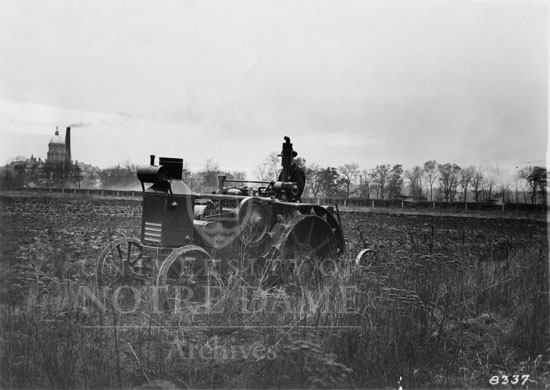
Father Edward Sorin and his compatriots began cultivating the land at Notre Dame shortly after their November 1842 arrival. The farms were developed “to provide food stuffs for its resident staff, faculty, and students, as well as to generate revenue to finance other aspects of its educational work.” [“The Notre Dame Farms, 1843-1940,” by Thomas Schlereth; The Old Courthouse News, winter 1975; PNDP 30-FA-8]
“An extensive complex of farm buildings was gradually constructed along the southeastern shore of St. Mary’s Lake as well as on the higher ground now enclosed by Corby, Sorin, Walsh, and Badin Halls” [Schlereth]

The farm buildings included an ice-house, slaughter house, horse barn, dairy and cattle barns, “wagon sheds, tool houses, corn cribs, implement sheds, and wheat granaries. … Scattered among the farm buildings were water toughs fed by windmills and wells” [Schlereth].
Around 1900, the University moved the farm to South Quad and built a number of buildings. “The farm complex included several farm houses for the brothers and hired hands, the University horse barn and livery, a dairy barn with a large Holstein herd, a circular barn and surrounding sties for raising over 700 Hampshire hogs, a hennery, and several grain-storage buildings. Fields of corn, alfalfa, and wheat stretched beyond these structures to the South Bend city limits” [The University of Notre Dame: A Portrait of Its History and Campus, Thomas Schlereth, page 150].


In 1900, Brother Leo Donovan became director of the Notre Dame farms. He went to Illinois and Iowa universities to learn agriculture techniques. He renewed the farms at Notre Dame, which had become severely depleted due to a lack of crop rotation and proper fertilization of the fields. In 1917, Brother Leo established an Agriculture School at Notre Dame, which was eventually discontinued in 1932.

Brother Leo also became renowned in animal husbandry. His livestock won many awards over the years at State Fairs and the International Stock Show in Chicago. “Named Indiana State Champion Feeder in 1937, he supplied and slaughtered (in structures formerly behind Moreau Seminary) all the beef and pork for the University kitchens and shipped the surplus to the Chicago stockyards” [UND, Schlereth, page 152].


On October 13, 1925, the Notre Dame barn on South Quad burned and the University moved the farms to land east of campus near Bulla Road. This newly opened space eventually made way for new dormitories and South Dining Hall. All farming activity was later moved to St. Joseph’s Farm in Granger, Indiana.

In 1867, the University bought 1300 acres of land near Granger and called this farm St. Joseph’s Farm, which “produced everything for the University from peat for fireplaces to tobacco for faculty cigars” [“The Notre Dame Farms,” Schlereth]. This farm was active until 1995, as it became less viable and there were fewer men entering the seminary with farming skills [South Bend Tribune, 03/18/1995, page A1, PNDP 30-Fa-8].
Sources:
PNDP 30-Fa-8
Brother Aiden’s extracts (PBAE, page 339)
Brother Leo Dononvan’s Papers (CLEF)
The University of Notre Dame: A Portrait of Its History and Campus, Thomas Schlereth
GMIL 1/04
GMLS 1/04
GTJS 04/45, 4/50
